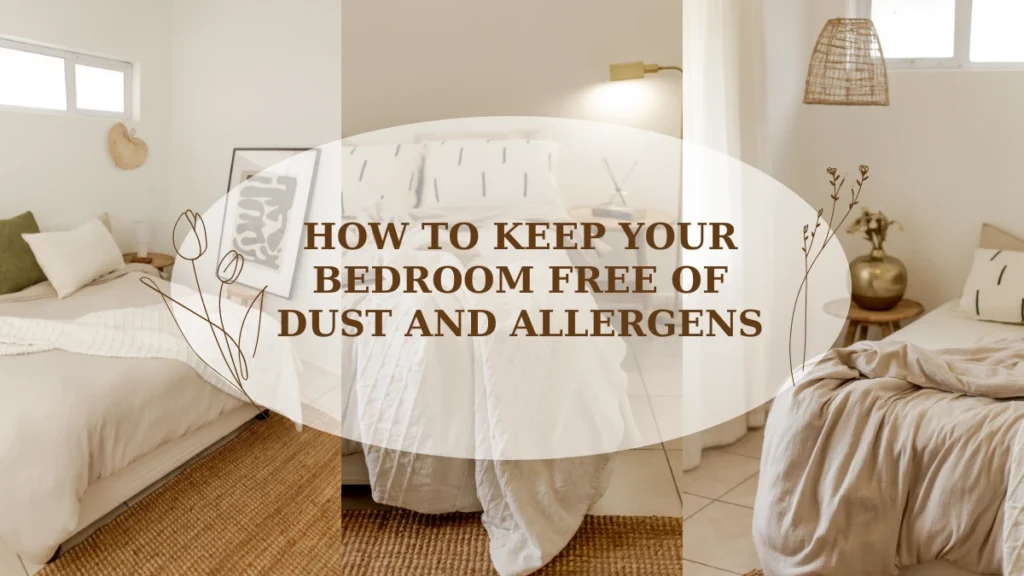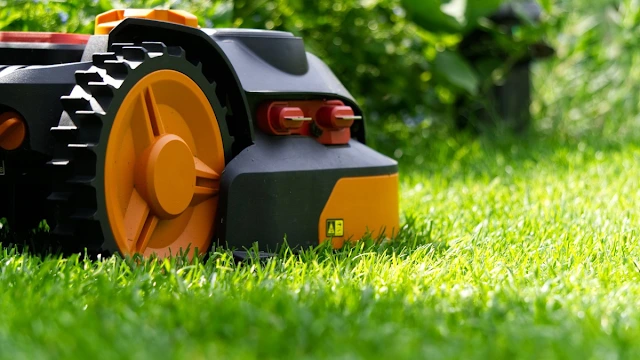
Keeping a bedroom clean and free of allergens requires thoughtful, consistent habits, as well as some key tools and products. This article breaks down practical steps to create a dust- and allergen-free environment for better sleep and well-being. Let’s start with the basics!
Why Dust and Allergens Accumulate in Bedrooms
Dust and allergens collect quickly in bedrooms due to the presence of soft surfaces, such as bedding, rugs, and curtains, that naturally trap particles over time. Every day, particles from outdoors, dead skin cells, pet dander, and clothing fibers settle in these materials. Even with windows closed, air ventilation systems and daily activities bring in dust that finds its way into our bedding and carpeting. As a result, dust and allergens like pollen and pet dander can easily settle, especially in hard-to-clean areas. Mattresses, carpets, and upholstered furniture act as magnets for these particles and, without regular cleaning, allow them to build up over time.
Health Risks of Dust and Allergens in the Bedroom
Exposure to dust and allergens can pose significant health risks, particularly for individuals with asthma, allergies, or respiratory conditions. Common symptoms include itchy eyes, sneezing, coughing, and congestion. In severe cases, dust and allergens may trigger asthma attacks or lead to chronic respiratory problems. Over time, breathing in dust mites, mold spores, and pet dander can weaken the immune system, making individuals more susceptible to infections. Children, elderly individuals, and those with compromised immune systems are especially vulnerable. Taking steps to reduce dust and allergens can reduce these risks and promote healthier sleep and overall wellness.
Daily Bedroom Cleaning Habits
Establishing simple daily cleaning habits is one of the most effective ways to prevent dust buildup. A quick, daily dusting routine can keep surfaces dust-free, making weekly deep cleans easier and faster. Use a microfiber cloth to wipe down nightstands, dressers, and window sills. Microfiber is excellent for capturing dust particles because it’s electrostatically charged, pulling in particles rather than simply moving them around. Another essential habit is opening the windows (weather permitting) to improve ventilation and reduce indoor pollutants. Fresh air circulation helps dilute indoor dust and prevents stagnation, keeping your room feeling fresh.
Weekly Deep-Cleaning Tips
While daily cleaning prevents the buildup of dust, a weekly deep-cleaning routine is necessary to reach hidden areas where dust can gather. Start by dusting hard-to-reach spots, such as the tops of door frames, ceiling fans, and light fixtures. Use a duster with an extendable arm or a microfiber cloth wrapped around a long handle to reach these areas without a ladder. Wipe down furniture surfaces with a damp cloth to capture dust effectively. Pay special attention to areas under the bed and behind furniture. These zones often go neglected but can harbor large amounts of dust if not regularly cleaned.
Choosing the Right Bedding Materials
Opting for hypoallergenic bedding is a simple yet powerful change in reducing allergens in your bedroom. Hypoallergenic fabrics, like tightly woven cotton, naturally resist dust mites and prevent allergens from embedding into the material. Bedding materials such as silk or bamboo also have antimicrobial properties, which inhibit the growth of mold and dust mites. Consider investing in dust-mite-resistant mattress and pillow covers that act as protective barriers between allergens and your bedding. They provide an extra layer of protection, minimizing direct exposure to allergens that can accumulate over time.
Washing and Replacing Bedding Regularly
Regularly washing and replacing your bedding is essential to minimize dust and allergens. Experts recommend washing sheets and pillowcases at least once a week, especially in hot water (130°F or higher) to kill dust mites effectively. Duvet covers, blankets, and mattress covers should be washed every two to four weeks. For allergy sufferers, encasing pillows and mattresses in washable covers offers added protection. Replace pillows every one to two years, as they can become a breeding ground for dust mites despite regular washing. Regular bedding maintenance can make a noticeable difference in reducing allergens and improving sleep quality.
Controlling Humidity Levels
Humidity plays a critical role in controlling allergens, especially dust mites, which thrive in humid environments. Keeping bedroom humidity between 30% and 50% can help prevent mold and dust mite growth. Using a dehumidifier can effectively control excess moisture, especially during humid seasons. To monitor humidity levels, consider investing in a hygrometer, an inexpensive tool that gives real-time humidity readings. Lowering the humidity makes it harder for allergens to survive, contributing to a healthier sleeping environment with cleaner air and fewer respiratory triggers.
Reducing Clutter to Minimize Dust Collection
Clutter provides a place for dust to settle and accumulate, making it more challenging to clean your space thoroughly. Reducing clutter helps create a cleaner, more breathable environment. Start by eliminating unnecessary items, such as decorative pillows, books, and knick-knacks, that collect dust on open surfaces. Using closed storage bins for smaller items can help contain dust. For items that you need to keep in the bedroom, such as jewelry, papers, or electronics, use dust-resistant containers to prevent dust from settling on them. This approach not only simplifies cleaning but also contributes to a calmer, more organized space.
Vacuuming Strategies for Reducing Dust
Vacuuming is essential to a dust-free bedroom, particularly if you have carpeting or area rugs. A vacuum cleaner with a HEPA (High-Efficiency Particulate Air) filter is highly recommended because it traps tiny particles, including dust mites, pollen, and pet dander. Vacuum carpeted areas, rugs, and under the bed at least once a week. For hardwood or tile floors, vacuum first to capture dust particles, then mop to ensure any lingering dust is removed. If possible, vacuum mattresses and upholstered furniture as well. This practice reduces the allergens that settle into fabric surfaces, contributing to cleaner air quality.
Air Purifiers: Do You Need One?
An air purifier can be a valuable tool for reducing airborne allergens in the bedroom. These devices use filters to trap dust, pollen, and pet dander from the air, making the bedroom environment cleaner and reducing potential allergy triggers. HEPA-filtered air purifiers are the most effective for trapping smaller particles, which are often the primary allergens. Select an air purifier that matches your room size, and place it in an area with good airflow. An air purifier can be particularly beneficial for individuals with severe allergies, providing cleaner, easier-to-breathe air at night.
Regularly Cleaning Curtains and Blinds
Curtains and blinds can quickly become covered in dust, which then spreads into the air when moved. To keep these window treatments clean, wash or vacuum curtains monthly. For those that can’t be laundered, use a vacuum with an upholstery attachment to remove dust effectively. Blinds, especially horizontal types, need weekly wiping to prevent dust buildup. A damp microfiber cloth works well to capture dust without dispersing it. Clean window treatments regularly to prevent them from becoming dust traps that affect the overall cleanliness of your bedroom.
Keeping Pets Out of the Bedroom
While it’s tempting to allow pets in the bedroom, pet dander is a common allergen and can worsen allergy symptoms. Dander consists of tiny, often microscopic, skin flakes that your pet sheds, which can easily become airborne and settle on surfaces. By keeping pets out of the bedroom, you reduce the amount of dander and hair in your sleeping area. If your pet does enter the bedroom occasionally, consider using a HEPA vacuum to clean the area afterward and groom your pet regularly to reduce shedding.
Using Natural Solutions to Minimize Dust
Natural cleaning solutions can be both effective and gentle on the environment, offering a safe alternative to harsh chemicals that can sometimes exacerbate allergies. Create a homemade dusting spray by mixing equal parts water and vinegar, with a few drops of essential oil (such as lavender or eucalyptus) for a pleasant scent. Use this spray on surfaces to help capture dust without releasing harmful chemicals into the air. For bedding, look for unscented or hypoallergenic laundry detergents to avoid irritating sensitive skin or respiratory systems.
Conclusion
Keeping your bedroom free of dust and allergens takes a bit of effort, but it’s well worth the investment for better health and quality sleep. From choosing hypoallergenic bedding to vacuuming regularly, each step contributes to a cleaner, more comfortable space. With a few simple habits and some well-chosen cleaning strategies, you can make your bedroom a sanctuary of fresh, allergen-free air, helping you rest and recharge without discomfort.
FAQs: Bedroom Cleaning
1. How often should I vacuum my bedroom?
Aim to vacuum weekly, paying special attention to carpets, rugs, and under the bed where dust accumulates most.
2. Can I use a regular vacuum instead of a HEPA vacuum?
Yes, but a HEPA filter captures more allergens, improving air quality.
3. Is it safe to use vinegar for dusting?
Yes, vinegar is a natural, non-toxic option that captures dust well and doesn’t leave a residue.
4. Are there specific bedding materials best for dust allergies?
Hypoallergenic materials like cotton, silk, or bamboo are ideal for dusting.
5. How do I choose hypoallergenic bedding?
Look for materials labeled “hypoallergenic” or “dust mite-resistant” to reduce allergens in your bedding.
Read More
https://cleaningview.ca/how-to-keep-your-bedroom-clutter-free-every-day/
Important: The information provided here in the post is for general informational purposes only. It should not be taken as professional or any other type of advice. Always seek the advice of a qualified professional before implementing this information on your own. Thank you!
Add CleaningView To Your Google News Feed


